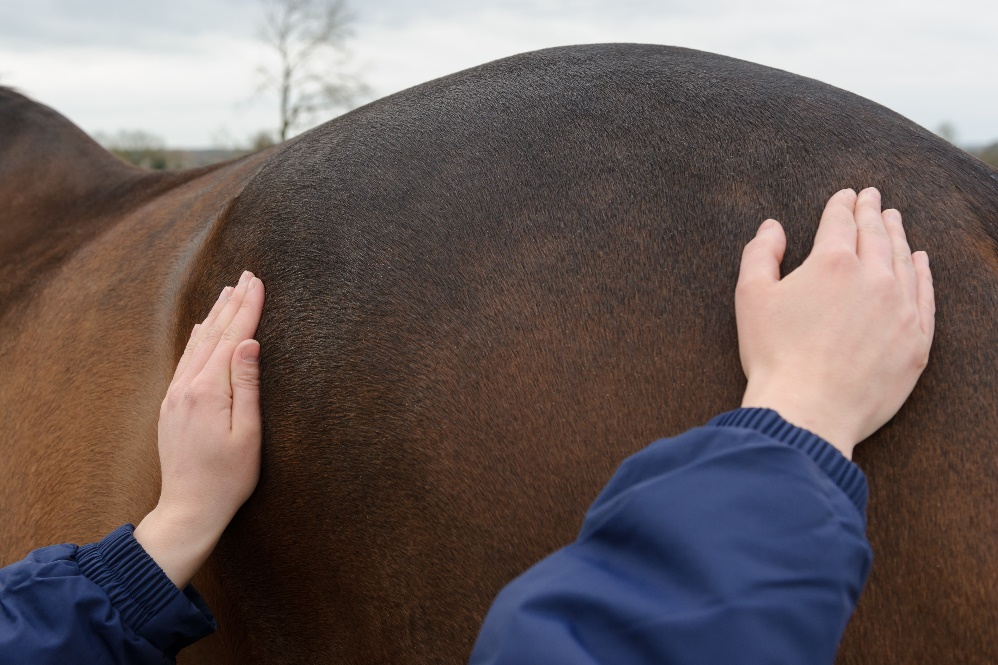The numbers of horses and ponies in the United Kingdom classed as overweight or obese are ever-increasing. Horses and ponies carrying excess weight are at increased risk of medical conditions such as laminitis, and so we all have a responsibility to ensure that our horses stay at a healthy bodyweight.
Fat Scoring is a hands-on approach to tracking your horse’s body condition, allowing you to feel any changes in your horse’s condition. Visual scores are rarely as accurate as hands-on scoring so it is important to thoroughly examine your horse. Often it can be really tricky to see the difference between muscle and fat, but when you feel it, it becomes much more obvious. Muscle feels firm whereas fat feels softer, more spongy and can sometimes also be lumpy.
Fat scoring isn’t only useful for horses who are overweight, it can be also be used to track progress in those who need to gain weight!
You should aim to score your horse once a fortnight, to track changes in condition before they become too dramatic and potentially cause health concerns. Ideally, this will be done by the same person as they will score in the same way; though there is nothing wrong with a second opinion.
Fat Scoring your horse involves splitting your horse into 3 areas:
- 1. Neck and Shoulders – everything in front of the shoulder blade
- 2. Middle – from behind the shoulder blades to the point of the hip
- 3. Quarters – the hips, pelvis and hindquarters

Each section is given a score from 0 to 5, and an average is taken for the whole horse. This is really important as horses do not store fat evenly over their bodies, some horses may appear “ribby” but have large amounts of fat over their neck, shoulders and hindquarters. These horses could actually have too much fat and be overweight despite being able to see their ribs.
Ideally you should aim for an overall body condition score of between 2.5 and 3 on a scale of 0 to 5, where 0 is very poor:

1 = Poor

2 = Moderate

3 = Good

4 = Fat

5 = Very Fat
Neck and Shoulders:
- Find the nuchal ligament and with thumb and first finger follow it along neck.

- Run your hand along the neck down towards shoulder and feel around the shoulder. If your horse has too much fat over the shoulder your hand will run smoothly from the neck to the shoulder, without the shoulder blade stopping your hand.
- Pinch flesh behind shoulder blade.

- Check for fat deposits in the supra-orbital fossa above the eyes.
You can then give your horse a score for the neck and shoulders, based on the criteria below:
0 – Very Poor = marked ewe neck, narrow and slack at base.
1 – Poor = ewe neck, narrow and slack at base.
2 – Moderate = Narrow but firm.
3 – Good = No crest (except stallions) firm neck, can clearly feel shoulder blade.
4 – Fat = slight crest, wide and firm. Build-up of fat over shoulder.
5 – Very Fat = Marked crest, very wide and firm, folds of fat over neck and shoulders.
Middle:
- Run your hand diagonally across their rib cage with firm pressure.

- Place your hand over the horse’s spine - your fingers should be curved over the spine, if it lies flat there is buildup of fat either side of the spine. Also look for a gutter along the spine.

- Feel for the spinous processes along the horse’s back.
0 – Skin is tight over ribs and ribs are very visible, spinous processes have sharp edges and are easily seen.
1 – Ribs easily visible, skin sunken either side of backbone, spinous processes well-defined.
2 – Ribs just visible, spinous processes felt. Hand forms C shape over spine.
3 – Ribs just covered, easily felt. No gutter along back, and hand doesn’t lie flat across the spine. Spinous processes can be felt.
4 – Ribs well covered, gutter along back bone.
5 – Ribs buried and cannot be felt, deep gutter, back is broad and flat.
Quarters:
- Place hand flat on top of horses hind-quarters and feel the top of pelvis
- Run your hand from the hind-quarters to the tail, feeling for the tail-bone

- Find the hips and curve your hand around to feel the outline of the bone

0 – Pelvis appears and feels angular with skin tight over bones. Rump appears sunken, with a deep cavity under tail and either side of croup.
1 – Rump is sunken but skin supple. Pelvis and croup well defined, cavity under tail.
2 – Rump flat either side of backbone, croup well defined with a slight cavity under tail. Some fat may be felt over the pelvis.
3 – Pelvic and tail bones are covered by fat and rounded, but pelvis is still easily felt.
4 – Fat forms a gutter to root of tail, pelvis covered but feels soft and can be felt only with firm pressure.
5 – Deep gutter to root of tail, skin distended and the pelvis buried and can’t be felt.
Once you have a score for each section, add them together and divide by 3. This will give your overall score!
In addition to this it can be useful to also monitor the belly girth measurement using a weigh tape. It can take a while for body condition score to change, but your horse’s internal fat could be reducing. By using a weigh tape you may notice smaller changes, which can encourage morale if it feels like you are not seeing any results.
Print off our Weight Card to make it easier to track and record your horse’s fat score and weight! Download via link below.
https://www.dodsonandhorrell.com/storage/Helpline_Weight_Chart_A5.pdf





